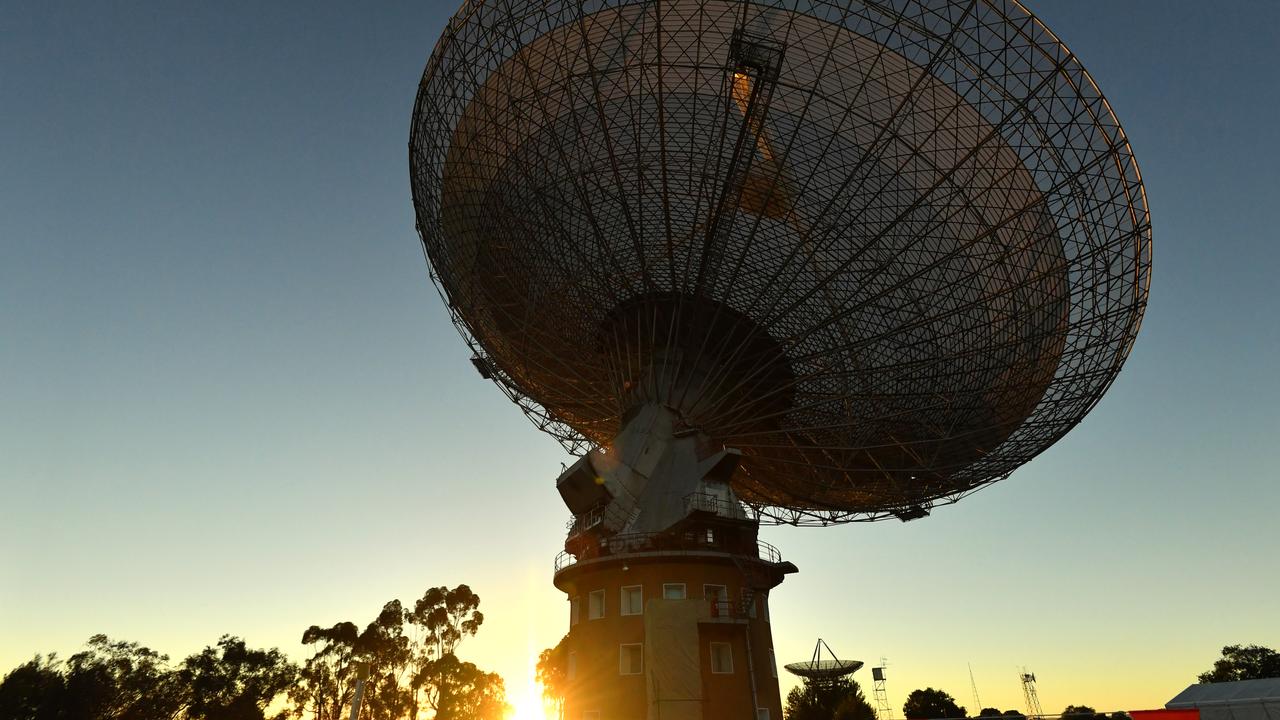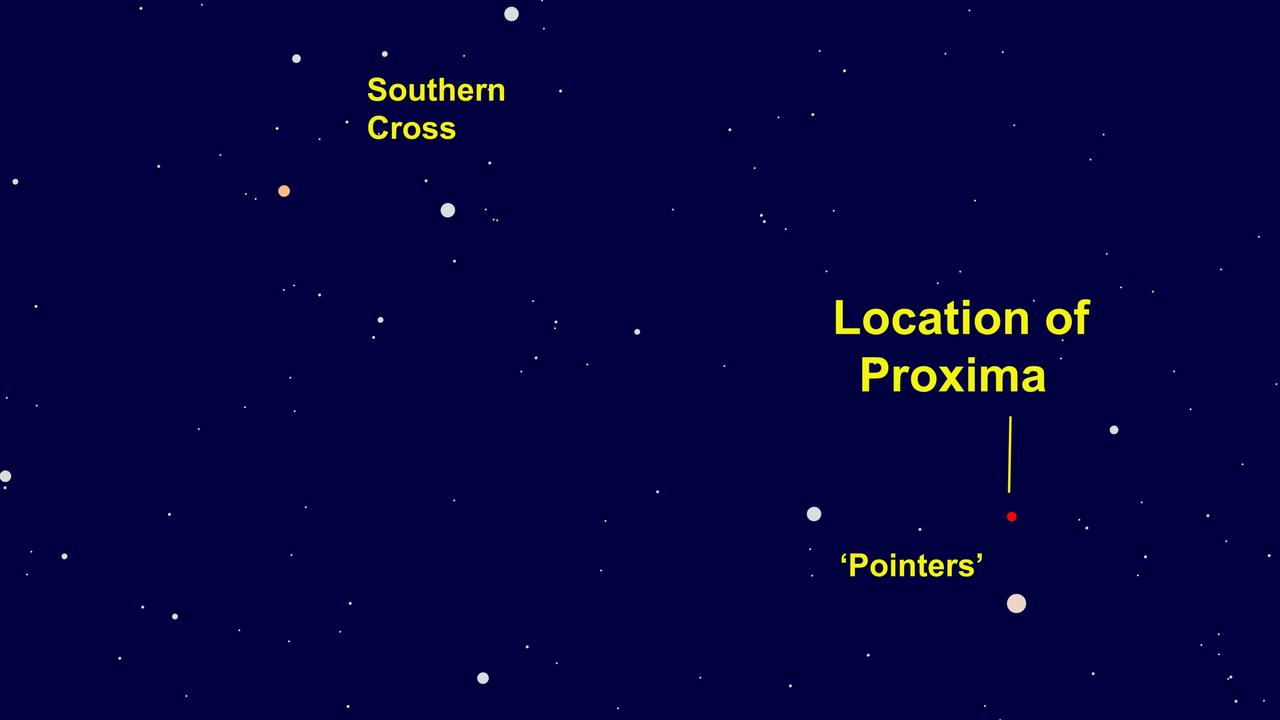Strange signal detected by Parkes telescope prompts alien search
Australia’s Parkes radio telescope was thrown into an extraterrestrial quest after a persistent signal was detected from another planet.
It was just one slightly bent line in a field of noise. But it wasn’t supposed to be there. What followed next drew Australia’s Parkes radio telescope into an extraterrestrial frenzy.
In April 2019, Australia’s CSIRO radio telescope near the town of Parkes in NSW heard something odd.
It was watching the nearby star Proxima Centauri. Its purpose was to observe the impact of solar flares on the red dwarf’s small system of planets. But such surveys also offer an opportunity to find signals that are more … manufactured.
And that’s what a review of the observations in 2020 appeared to find.
There was good reason to be excited.

First, there was the direction it was coming from. Proxima Centauri is too faint to see. But it’s our closest neighbour at just 4.22 light years. And it’s thought to have at least one habitable planet.
Second, it was persistent. It was there for several hours. And it wasn’t heard when the 64m-wide telescope looked away every 30 minutes or so.
Third, it was narrowband – a specific 980.002MHz with no spillover “noise” usually associated with natural events.
Fourth, the signal’s frequency “drifted” slowly, indicating movement through space.
Combined, these are a strong set of indicators for a “technosignature” – a non-natural, non-Earth generated radio signal.

But, there was a problem. It was never seen again.
That didn’t stop the excitement from boiling over. This, after all, was a potential “Wow!” signal like the legendary 1977 event.
News of the find hit the media last year.
First contact
At first glance, it was precisely what they were looking for.
Russian billionaire Yuri Milner founded the $133 million Breakthrough Listen Initiative project. Its purpose is to scan the skies in the hope of finding traces of extraterrestrial civilisation.
The Australian Parkes radio telescope is just one part of the project. Similar devices around the world devote some of their time to the search.
The Parkes signal was the initiative’s first real hope of actually having found something. As such, it was named Breakthrough Listen Candidate 1 (BLC-1).
The world’s extraterrestrial search community, SETI, turned its eyes towards Proxima Centauri.
They were prepared with a variety of equipment to determine everything they could from such a signal. Only such detailed follow-up analysis could confirm that its source was alien, not some kind of unexpected “spoof” (false signal).
Nothing more was seen.

“If BLC-1 is never seen to repeat, it will be very difficult to conduct the kind of detailed follow-up that will fully convince scientists that it was a message from aliens,” Breakthrough Listen advisory board member Professor Michael Garrett observed earlier this year. “Sceptics will rightly argue that this is more likely to be either a new form of human-generated radio interference or a rare feature of the complex observing instrumentation itself.”
Amp overdrive
“The trouble was, we weren’t ready to discuss it,” Curtin University radio astronomer Dr Danny Price says of the media excitement surrounding the signal. “Last year we had only just started secondary verification tests, and there were too many unanswered questions.”
Decades of false hopes have given SETI and Breakthrough Listen cause for caution. Moments of immense excitement are almost always followed by a let-down.
“When you’re searching for signs of extraterrestrial life, you want to be very careful about getting it right before you make any announcements,” Dr Price says.
The Breakthrough Listen project scientist says the search team is now finally ready to discuss the Proxima Centauri signal mystery.
A Breakthrough Listen SETI (@BerkeleySETI) search towards Proxima Centauri has detected a radio signal... but it is very likely to be terrestrial. @SETI_Sheikh and team describe how they verified the signal's origin: https://t.co/RujWapIL0Fpic.twitter.com/9csji2DBtV
— Nature Astronomy (@NatureAstronomy) October 25, 2021
Two studies have been published in Nature Astronomy today.
“Today, we are ready to report that BLC-1 is, sadly, not a signal from intelligent life beyond Earth. Rather, it is radio interference that closely mimics the type of signal we’ve been looking for.”
The signal, and the circumstances under which it was captured, were exhaustively tested.
The conclusion: BLC-1 is most likely interference. Intermodulation, to be exact.
“If you’ve listened to blues or rock guitar, you are probably familiar with intermodulation,” Dr Price says. “When a guitar amp is deliberately overdriven (when you turn it up to 11), intermodulation adds a pleasant-sounding distortion to the clean guitar signal. So BLC1 is – perhaps – just an unpleasant distortion from a device with an overdriven radio frequency amplifier.”
Looking ahead
BLC-1 is almost certainly a spoof. It’s an effect that has been seen in radio astronomy before.
“It’s disappointing to have our hopes of finding other intelligent life out there dashed yet again,” Flinders University space archaeologist and Space Industry Association advisory council member Dr Alice Gorman says.
“Longing for company in the vastness of the cosmos is such a strong human impulse. But there are still reasons to be cheerful about the results of this study. Because the team approached the analysis with such rigour, we know that if there is a future signal which suggests a technosignature, we can rely on the evidence. Now we know a little bit more about what not to look for.”
But Breakthrough Listen Initiative and SETI remain committed to their search.
Their biggest challenge remains verification.
Professor Garrett says one way to prevent such “false positives” again is to use two widely separated radio telescopes to search in tandem. The odds of the same interference affecting both at the same time are incredibly remote. And that would help sift the wheat from the chaff.
“The human-made interference that has contributed to so many false positives for SETI, and has included orbiting satellites and even microwave ovens, would completely disappear,” he says.
But, there’s more.
“By combining their signals using a powerful technique known as Very Long Baseline Interferometry, we can pinpoint the position of a signal with exquisite accuracy, such as to a single star,” he says.
"Regardless of what caused BLC1, it was not the technosignature we were looking for. It did, however, make for an excellent case study, and showed that our detection pipelines are working and picking up unusual signals," says Danny.
— CSIRO_ATNF (@CSIRO_ATNF) October 25, 2021
In the case of nearby Proxima Centauri, even a specific planet could be singled out.
Doing so, however, isn’t easy.
That would require allocating precious time from two radio telescopes. Making it more difficult would be making such an allocation concurrent. Then, the immense amounts of data both telescopes receive will need much greater computing power to combine and sift through.
“But none of these issues are showstoppers, especially as technology continues to advance at unprecedented rates,” Professor Garrett says.
Jamie Seidel is a freelance writer | @JamieSeidel






